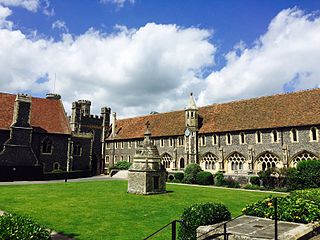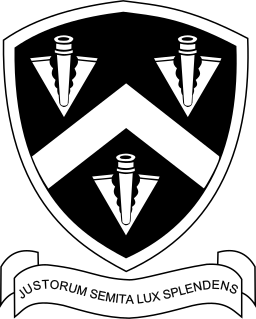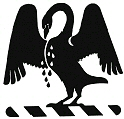
The King's School is a public school in Canterbury, Kent, England. It is a member of the Headmasters' and Headmistresses' Conference and the Eton Group. It is Britain's oldest public school; and is arguably the oldest continuously operating school in the world, since education on the Abbey and Cathedral grounds has been uninterrupted since AD 597.

North East England is one of nine official regions of England at the first level of ITL for statistical purposes. The region covers an area of 8,592 km2 and in 2019 had a recorded population of nearly 2.7 million. There are four counties in the region: County Durham; Tyne and Wear; Northumberland and part of North Yorkshire. The largest settlements are Newcastle upon Tyne, Middlesbrough, Sunderland, Gateshead, Darlington and Hartlepool. There are three conurbations in the region: Tyneside ; Wearside ; and Teesside. Only three settlements in the region have city status: Newcastle upon Tyne, Sunderland and Durham.

Charterhouse is a public school in Godalming, Surrey, England. Originally founded by Thomas Sutton in 1611 on the site of the old Carthusian monastery in Charterhouse Square, Smithfield, London, it educates over 800 pupils, aged 13 to 18 years. Charterhouse is one of the 'great' nine English public schools reported upon by the Clarendon Commission in 1864 and is a member of the Rugby Group schools. Today pupils are still referred to as Carthusians, and former pupils as Old Carthusians. Charterhouse is regarded to be among the most prestigious schools in the world due to the school's history and influence.

North Tyneside is a metropolitan borough in the metropolitan county of Tyne and Wear, England. It forms part of the greater Tyneside conurbation. North Tyneside Council is headquartered at Cobalt Park, Wallsend.

South Shields is a coastal town in South Tyneside, Tyne and Wear, England. It is situated at the south of the River Tyne. Historically, it was known to Romans as Arbeia and as Caer Urfa by Early Middle Ages. According to the 2011 census, the town had a population of 75,337. It is the fourth largest settlement in Tyne and Wear; after Newcastle upon Tyne, Sunderland and Gateshead. It is roughly equidistant (approximately 3.7 miles between the border of Newcastle and the border of Sunderland.

Whitley Bay is a seaside town in the county of Tyne and Wear, North East England. Historically in Northumberland, it has been administered as part of the metropolitan borough of North Tyneside since 1974 and forms part of the wider Tyneside located around 10 miles east of Newcastle upon Tyne. The former village of Monkseaton is part of the town.

Tynemouth is a coastal town in the metropolitan borough of North Tyneside, North East England. It is located on the north side of the mouth of the River Tyne, hence its name. It is 8 mi (13 km) east-northeast of Newcastle upon Tyne.
Tynemouth Castle is located on a rocky headland, overlooking Tynemouth Pier. The moated castle-towers, gatehouse and keep are combined with the ruins of the Benedictine priory where early kings of Northumbria were buried. The coat of arms of the town of Tynemouth still includes three crowns commemorating the tradition that the Priory had been the burial place for three kings.

North Shields is a coastal resort on the River Tyne's north bank in the North Tyneside borough, northern England. It is a large area of Tynemouth and 8 miles (13 km) north-east of Newcastle upon Tyne.
Monkseaton is an area of Whitley Bay, North Tyneside, in the North East of England. Historically in Northumberland, it is in the north-east of the borough, 3⁄4 mile from the North Sea coast and 1+1⁄2 mi (2.5 km) north of the River Tyne at North Shields. One mile to the north of Monkseaton, the extensive built-up areas of North Tyneside change abruptly into green belt stretching north into south-east Northumberland. It is at an elevation of 130 feet (40 m) above sea-level.
Ysgol Eirias, is a secondary school situated in Colwyn Bay, in Conwy county borough, North Wales. The school has approximately 1600 pupils and over 120 teachers and staff. The school’s name is derived from its location, the grounds of Eirias Park. The current headteacher is Sarah Sutton, taking over from Phil McTague in 2017, who took over from Clive Hampton in 2006.

Bloxham School, also called All Saints' School, is an independent co-educational day and boarding school of the British public school tradition, located in the village of Bloxham, three miles (5 km) from the town of Banbury in Oxfordshire, England. The present school was founded in 1860 by Philip Reginald Egerton and has since become a member of the Woodard Corporation. The current headmaster is Paul Sanderson, who took over from Mark Allbrook in 2013. The school has approximately 515 pupils.

Elswick is a district and electoral ward of the city and metropolitan borough of Newcastle upon Tyne, England, 1.9 miles west of the city centre, bordering the River Tyne. Historically in Northumberland, Elswick became part of Newcastle upon Tyne in 1835. Elswick is home to the Newcastle Utilita Arena; and Newcastle College, with approximately 45,000 students.

Chatham House Grammar School was an all boys grammar school in Ramsgate, Kent, England, that was merged in September 2011 with its sister school Clarendon House Grammar School to become the Chatham & Clarendon Grammar School.

King's College is an independent co-educational secondary day and boarding school in Taunton, Somerset, England. A member school of the Woodard Corporation, it has approximately 450 pupils aged 13 to 18, including about 300 boarders. Its affiliated prep school is King's Hall School. The head of the school is currently Richard Biggs, who started his first academic year in the winter of 2007.

Ellesmere College is a fully independent co-educational day and boarding school set in rural northern Shropshire, located near the market town of Ellesmere. Belonging to the Woodard Corporation, it was founded in 1884 by Canon Nathaniel Woodard.

Tyne Metropolitan College is a college of further education in North Tyneside, England.

The 1973 Tyne and Wear County Council election was held on 12 April 1973 as part of the first elections to the new local authorities established by the Local Government Act 1972 in England and Wales. 104 councillors were elected from 95 electoral divisions across the region's five boroughs. Each division returned either one or two county councillors each by First-past-the-post voting for a four-year term of office. The election took place ahead of the elections to the area's metropolitan borough councils, which followed on 10 May 1973.


















